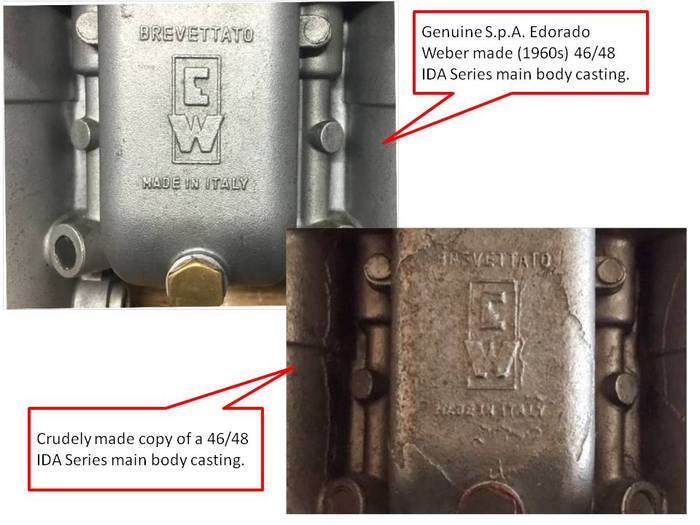Weber 48 IDA Series Carburetor. Made in Italy, made by the original "Weber" company, maybe but maybe not.
The question of whether or not any specific carburetor or sets of carburetors was made in Italy and made by the famous carburetor company S.p.A. Edorado Weber in the 1960s is of interest to some car owners and their restorers. Some might want carburetors made in specific time frames as there was not "a" carburetor but a series of them that evolved over time in several ways before 1970. This commentary does not cover units made by the original company late 1970 onward or the modern company 1992 or later.
Take note and buyer beware as not all "MADE IN ITALY" marked 48 IDA type carburetors in the marketplace are genuine "originals", i.e. not every one was made by the company that you think made them. I will let those interested look up the words resemblance and or counterfeit.
I see some 48 IDA, 48 IDA-1, and lots of 48 IDA4 models for sale that have a few to multiple details inconsistent with the several hundred known genuine examples produced by the S.p.A. Edorado Weber (Weber) firm in Italy. I once saw two (2) each bogus serial number 1 48 IDA carburetors for sale while attending a single SAAC convention. At least three entities have produced counterfeit parts and carburetors since the 1970s. All the main body castings indicated that they were made in Italy. Were they? I have no idea but they sure are not consistent with what E. Weber actually made. I have read in print that the first counterfeits started showing up in the United Kingdom by 1971 and that includes service parts and whole carburetors. I have read about and corresponded with racers about some of the issues users suffered were believed to have resulted in getting bogus parts and or carburetors mixed into their racing induction systems.
The common context is a seller claiming their offering(s) is(are) genuine Weber made in Italy during the 1960s carburetors solely based on the detail of having "MADE IN ITALY" cast into the main bodies. That line of text is not an automatic verification of authenticity. So, how does one identify a potential counterfeit? In broad terms the two situations that automatically call my attention to them is 1) mixed features and 2) poor aluminum castings quality. One can drill down to smaller details but most of the time one does not have to do much study.
Mixed Features: Many of the parts from main body castings to small ancillary parts were made in series that change specifications over time. If an used assembly has let us say design features of two to several different 'factory' periods mixed into one carburetor, that has me examine the unit more carefully. Notes: 1) Restored carburetors almost always have mixed time frame and or design parts incorporated in them. That makes evaluating them more difficult. 2) At least one clever person has started modifying 1970s and later E. Weber made carburetors to closely mimic 1960s versions right down to restamping of model and serial numbers.
Poor Aluminum Castings (body and cover): E. Weber had very nice aluminum die casting molds to produce the blanks for these parts. The best counterfeit castings are often very hard to identify as such because the makers went to a lot of trouble to produce their castings. One version of counterfeits has very poorly done castings. Take a look at the image below. It looks like somebody made something like a plaster cast of a genuine body and hand poured their versions. Not shown but there are gaps in places in the mounting flanges where metal did not get to. This one is really easy to spot as not genuine even though it says "MADE IN ITALY" on it.

How many bogus carburetors are out in the world? I have no idea. In my database I have enough very questionable units to be aware that inconsistent ones are out there.
Enter the reproductions of 48 IDM carburetors currently in development. Not counterfeits as they are being created with well advertised descriptions as reproductions. Before the die cast aluminum bodies and covers 46/48 IDA family there was the heavy sand cast bodies and covers 46/48 IDM family used by just about anybody racing early 260/289 Ford powered sports cars, including Cobras. Being created and advertised as reproductions there might be a point in time when the second or subsequent owner does not realize that they are reproductions. Just think of all the clearly reproduction "COBRA" lettered parts that get offered for as genuine 1960s factory pieces!
Bear all this in mind when somebody offers some "real" made in Italy carburetors for sale.